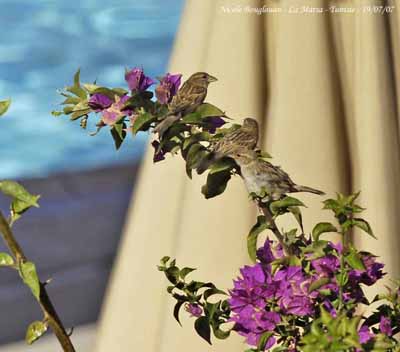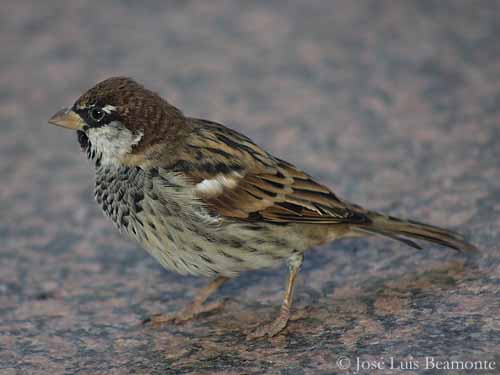
Fr: Moineau espagnol
All : Weidensperling
Esp : Gorrión Moruno
Ital: Passero spagnolo
Nd: Spaanse Mus
Sd: Spansk sparv
Port: Pardal-espanhol
Photographers :
José Luís Beamonte
Pájaros de España
Nicole Bouglouan
PHOTOGRAPHIC RAMBLE
Text by Nicole Bouglouan
Sources:
HANDBOOK OF THE BIRDS OF THE WORLD Vol 14 by Josep del Hoyo-Andrew Elliot-David Christie - Lynx Edicions –
ISBN: 9788496553507
THE HANDBOOK OF BIRD IDENTIFICATION FOR EUROPE AND THE WESTERN PALEARCTIC by Mark Beaman, Steve Madge - C.Helm - ISBN: 0713639601
ENCYCLOPEDIE DES OISEAUX DE FRANCE ET D’EUROPE – de Peter Hayman et Rob Hume - Flammarion – ISBN : 2082009920
GUIDE HEINZEL des Oiseaux d’Europe de Hermann Heinzel, Richard Fitter et John Parslow – Delachaux et Niestlé – ISBN : 2603014862
Pájaros de España (JL Beamonte)
Wikipedia (Wikipedia, The Free Encyclopedia)
Spanish Sparrow
Passer hispaniolensis
Passeriforme Order – Passeridae Family
BIOMETRICS:
Length: 15 cm
Wingspan: 23-26 cm
Weight: 24-32 g
DESCRIPTION:
Slightly larger and heavier than the House Sparrow, the Spanish Sparrow differs in plumage, bill-shape and range, although in some areas, and especially in Mediterranean regions, both species hybridize, making more complicated the taxonomy of these species.

The Spanish Sparrow adult in summer has very contrasted plumage. Crown and nape are bright chestnut, whereas throat and breast are black. The black extends to flanks and lower breast ending in streaks more or less visible.
Back and scapulars are dark brown, almost black, making this bird different from the House Sparrow. Cheeks are pure white. The wings show a white conspicuous wingbar formed by the coverts’ edges. Belly and tail are dark.
The bill is black. We can see a black line from the bill base and through the eyes, making them darker. Legs and feet are brownish.
In winter plumage, the male is duller and paler, with greyish or yellowish tinge.
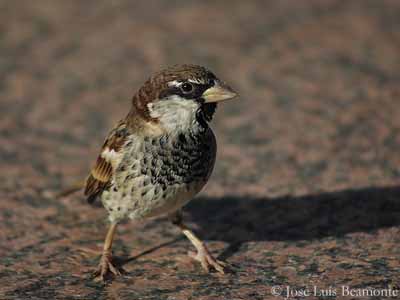
Female is almost similar to the House Sparrow, however, she has indistinct dark streaks on flanks, and all her plumage show larger contrast between the dark upperparts and the paler underparts.
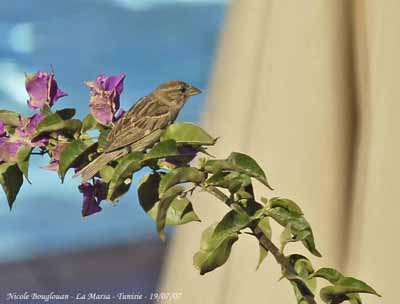
Juvenile resembles female but it is paler and duller. It lacks the white collar and the streaks on the underparts.
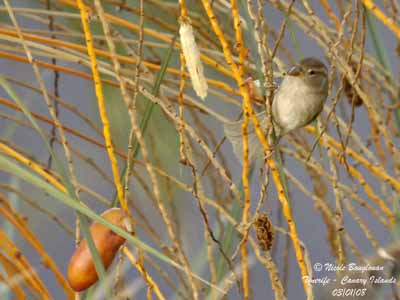
We find two subspecies:
P.h. hispaniolensis is found in Spain, Sardinia, Greece and Balkans, W Asia Minor, E Atlantic islands such as Madeira, Canary Islands and Cape Verde, and NW Africa.
P.h. transcaspicus occurs in Cyprus, A Turkey and Levant E to Iran, Afghanistan, S Kazakhstan and NW China.
Both races are very similar, except after the moult. They are paler, mainly the female.
VOICE: SOUNDS BY XENO-CANTO
The Spanish Sparrow is very noisy. Its voice is less harsh and more pleasant than that of the House Sparrow.
It gives an insistent “chop”, but also short and melodious varied trills. The flight call is a “churp”. The contact call is “que que que”. The alarm call is a nasal « quer » or « quer-it-it ». The threat call is a nasal “chur-it-it-it”.
Males utter rapid and repeated “cheeli-cheeli-cheeli” to attract the females. These sounds are louder and higher-pitched than in House Sparrow.
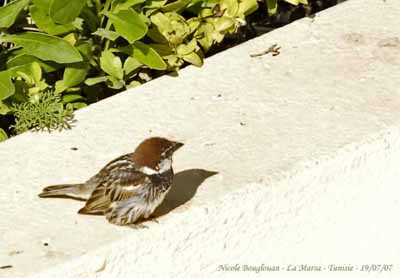
HABITAT:
The Spanish Sparrow frequents the countryside, more or less close to humans. It prefers the wet areas near water with trees and shrubs, open areas with scattered trees, harvested fields, cultivated areas, roadsides and tracks. It enters the urban areas from which the House Sparrow is absent.
RANGE:
The eastern populations, and especially the race “transcaspicus”, are highly migratory, moving southwards to Egypt and Arabia.
The Spanish Sparrow is found in Canary Islands, N Africa, from Morocco to N Libya, Spain, Sardinia, Balkans and Greece.
It winters in Spain, N Africa, Middle-East, C Asia, N Pakistan and NW India. Populations living on islands are sedentary.
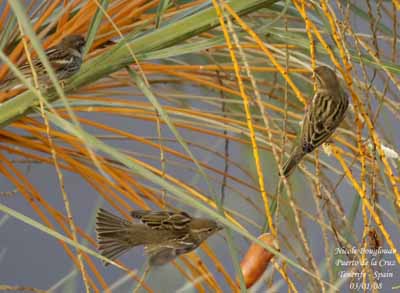
BEHAVIOUR:
The Spanish Sparrow is very gregarious, and during the breeding season, it forms huge colonies of hundreds or even thousands pairs. The roosts gather great numbers of birds too.
As soon as February, the displays become more intense, and mainly from March with frequent displays by the males, very similar to those of the House Sparrow.
The male gives an advertising song to indicate the nest-site, a rapid “cheeli-cheeli-cheeli”. This song is accompanied by displays. The male has dropped and vibrating wings, raised and spread tail, and raised head too, to expose the black bib. If the female is not ready to copulate, she may eject the male very strongly.
The first nests are built in April or in early May.
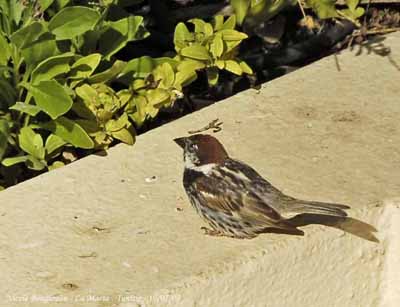
Partially sedentary, the Spanish Sparrow moves according to the ecological variations within the area where it is living. To feed, it catches insects on the ground, but also on leaves in trees and bushes, and by flycatching in front of the vegetation and taking flying insects.
It feeds mainly on vegetal matter, grass and seeds, but the young are fed with insects, and then, with an increasing proportion of vegetal food.
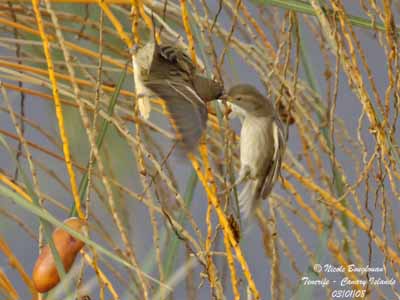
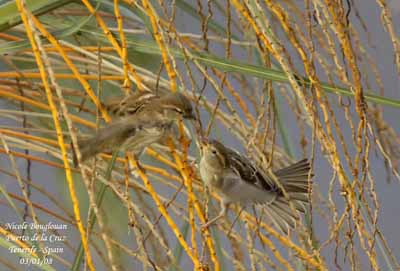
FLIGHT:
In spring and autumn, the Spanish Sparrow forms large flocks as the migratory birds do, flying low from the ground and very fast.
REPRODUCTION:
Breeding season varies according to the range, and several broods, 2-4, are raised by adults.
The Spanish Sparrow’s nest is placed in trees, on outer branches and mainly in Eucalyptus, below or close to large nests such as Stork’s nests or Kite’s nests.
The nest is fairly bulky and slightly hanging. In oaks and pines, they are spherical with side entrance. They are built by both adults with straw, fine loosely woven grasses, and the cup is lined with feathers, down and sometimes hair. The pairs starting to breed in March may produce three broods per season.
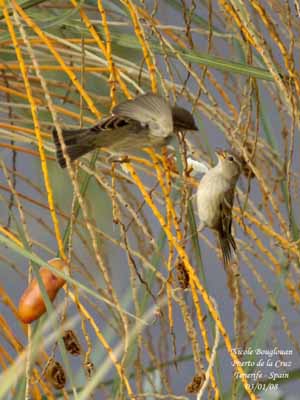
Female lays 2-6 white eggs, sometimes washed green or blue with variably coloured speckles. Incubation lasts 11-14 days, shared by both parents, but mainly by female.
At hatching, the chicks are naked. The male feeds them intensively, more than the female.
They fledge at 11 days of age, but they are unable to fly, and numerous chicks die while falling from the nest. If they leave the nest about 15 days after hatching, they are more able to survive. They will be independent at about 25-28 days.
DIET:
The Spanish Sparrow has very varied diet. It feeds mainly on grain and seeds in plantations and from the ears too. They are very attracted by the ricefields. During winter, it feeds mainly on wild seeds, and during spring, it also feeds on insects and larvae and feeds the chicks at nest with them. It also catches caterpillars, grasshoppers, flying ants and Coleopterans.
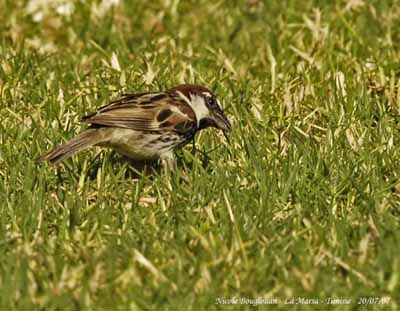
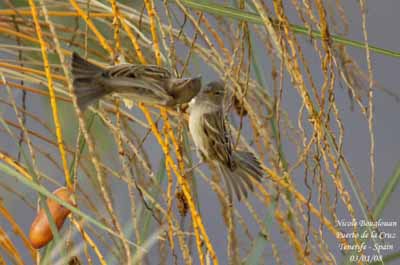
PROTECTION / THREATS / STATUS:
The Spanish Sparrow is common and locally abundant.
The intensification of irrigated cultivation involved the increase of populations, in spite of attempts at control by farmers. When the numbers are too large, this species becomes a pest for agriculture.
However, the species is common and not threatened at this moment.
